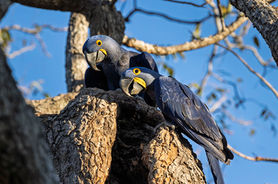Pantanal Brazil
The Pantanal is the world's largest tropical wetland, a vast wilderness in central Brazil on the borders of Bolivia and Paraguay. Its low land, formed from an ancient sea, floods in the rainy season, slowly draining out into the Paraguay river. It is known for its incredible wildlife, including the world’s largest concentration of crocodilians, the Yacare Caiman, the powerful jaguar, the world’s largest cat with a population of about 4,000 to 6,000, the giant river otter and the capybara, the world’s largest rodent. In the dry season, as it was at the time of my visit, the floods recede and the jaguars concentrate on the river banks where their prey, including the caiman, capybara and otter live. They are therefore adapted as excellent swimmers and powerful enough to kill caiman by a single bite to the spinal cord. We flew to Cuiabá, capital of Matte Grosso state, and bussed 140 km on a single dirt road to reach our lodge on the banks of the river Rio São Lourenço, spending five days in river excursions to explore the wildlife. We spotted several jaguars each day along the banks. Not all were in photogenic locations but notably a number were found up trees that I have included in this post including one attempting an unsuccessful jump from a tree onto an unsuspecting caiman. Jaguar have unique markings. Incidentally, they don’t roar but frequently yawn, which can look equally dramatic. More follows.
The most common caiman in the Pantanal is the Yacare Caiman. Males grow to a total length of 2–3m and weigh around 40–50 kg, while females grow to 1.4m long and about 15–20 kg. Its diet primarily consists of aquatic animals, such as snails, and occasionally land vertebrates and here pictured with a fish! We witnessed a jaguar kill a caiman under water adjacent to the bank and swim across the river with it before ascending the bank and disappearing into the undergrowth.
There are five species of kingfisher in the Pantanal: the Ringed Kingfisher, Amazon Kingfisher, Green Kingfisher, Green-and-Rufous Kingfisher, and the American Pygmy Kingfisher. These birds are a common and captivating sight in the region's abundant rivers and swamps, with the Ringed Kingfisher being the largest and most common of the group. My technique developed enough in time to capture one or two coming out of the water with a fish but it was made easier by the guide having provided the meal.
Capybaras thrive near the water's edge, with their high-set eyes and webbed feet suiting a semi-aquatic lifestyle. They are a primary food source for predators like jaguars and caimans, though their population is threatened by habitat destruction. Here it is accompanied by a Tyrant fly catcher feeding on its parasites.
The giant otter is a carnivorous mammal. It is a social species, with family groups typically supporting three to eight members, centred on a dominant breeding pair, and are extremely cohesive and cooperative. Its population has been greatly reduced by decades of poaching for its velvety pelt. It is also adapted to an amphibious lifestyle, including exceptionally dense fur, a wing-like tail, and webbed feet. It constructs extensive campsites close to feeding areas, clearing large amounts of vegetation. It subsists almost exclusively on a diet of fish but may also eat crabs, turtles, snakes and small caimans.
We spotted capuchin monkeys and also howler monkeys although I did not get acceptable pics of these.
























